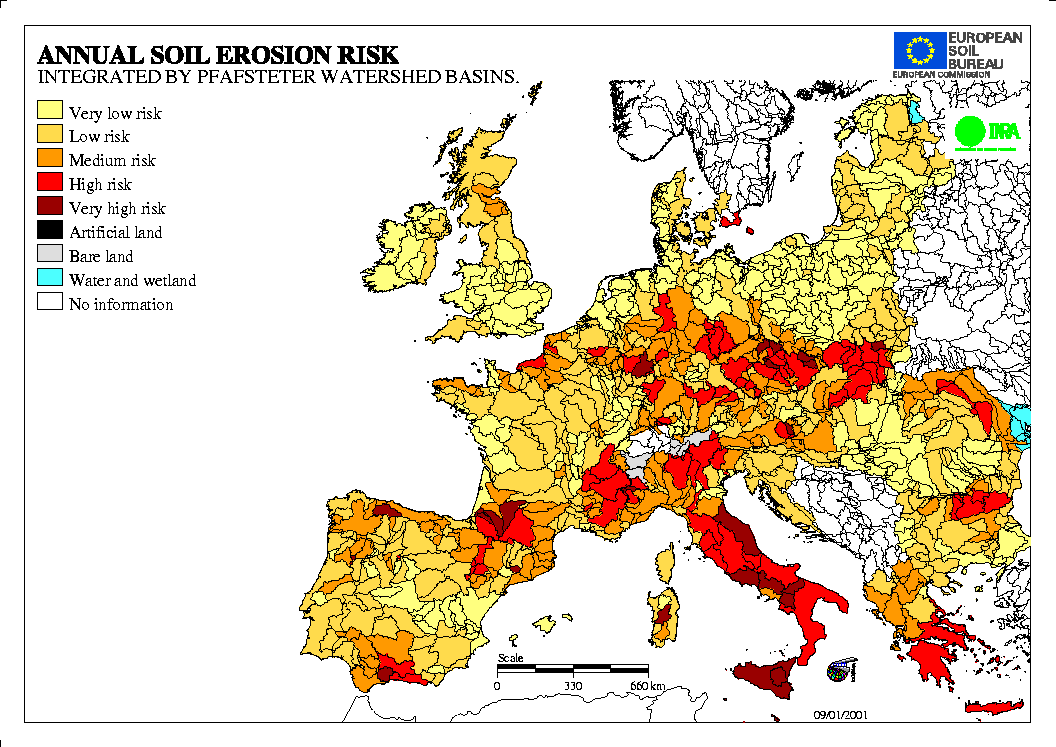
Soil erosion risk in Europe (European Commission 2008)
Frans J.P.M. Kwaad
Visit also:
Images of soil
erosion , where 12
slideshows of features of soil erosion can be viewed.
Ephemeral Gully Erosion
Economic
costs of soil erosion
Keywords: soil conservation, soil erosion, erosion control, conservation tillage, erosiebestrijding, niet-kerende grondbewerking, Europe, Nederland, België, Zuid-Limburg
This site is about soil erosion control in Europe. Soil erosion is as old as agriculture. Stated in simplest terms, conservation of the soil is a matter of using land as it should be used. Proper use of the land is governed by certain physical factors. When it is used without regard for these factors, the processes of waste begin. Certain factors of an economic and social character also influence the use of land. Men who farm the land must make a living. That is their most realistic and immediate concern. Economic need is a powerful factor in determining how they use the land, a factor that usually outweighs less urgent considerations of conservation. Social patterns likewise are a landuse factor. As they affect the interests of the individual operator, economic and social influences are as much a part of the problem of soil conservation as the purely physical processes through which soil is washed or blown away. These words, written by Bennett in 1939, are as valid today as they were seventy years ago.
Bennett, H.H., 1939. Soil
Conservation. McGraw-Hill Book Company, New York, 993 pp.

Soil
erosion
risk
in
Europe
(European
Commission
2008)
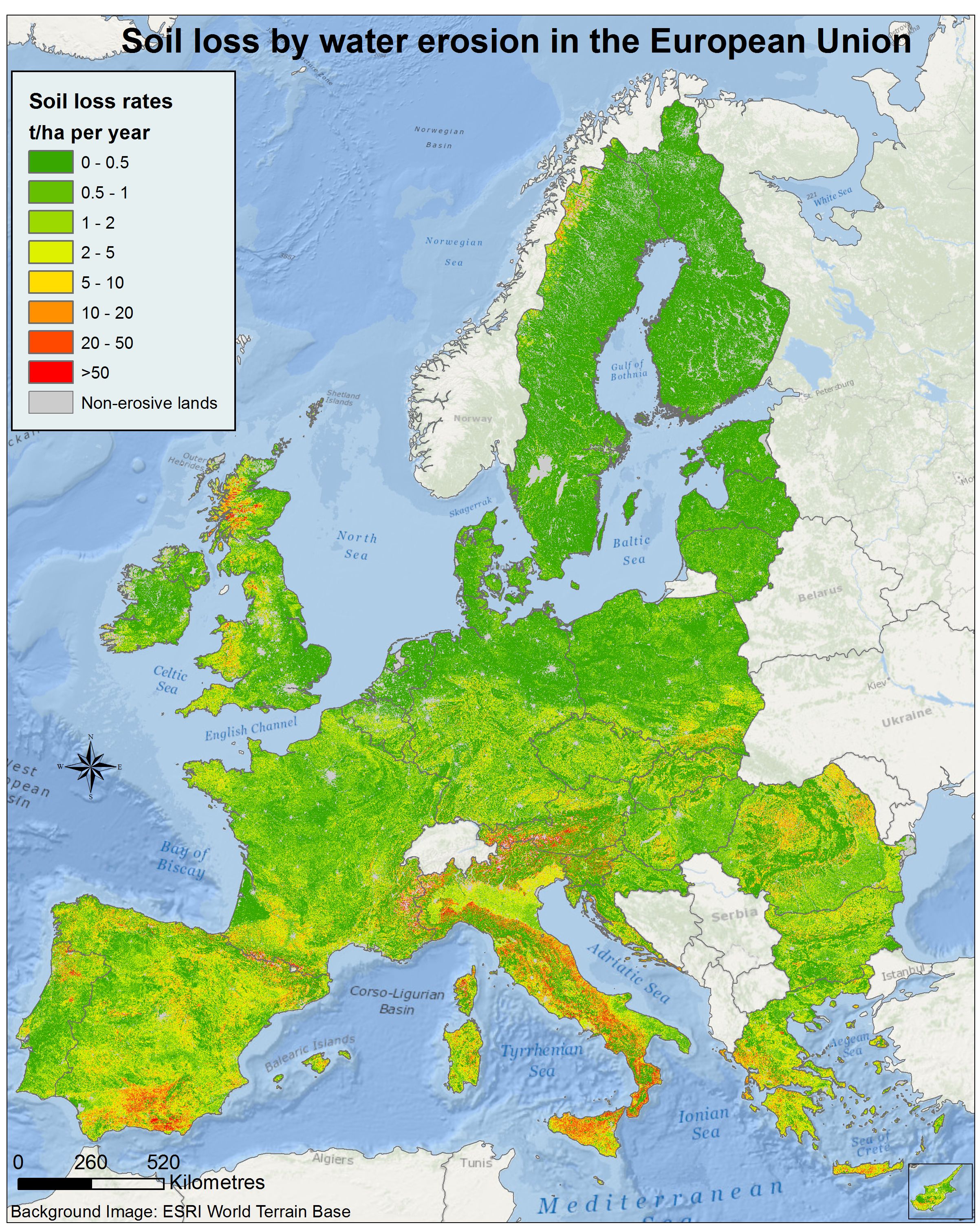
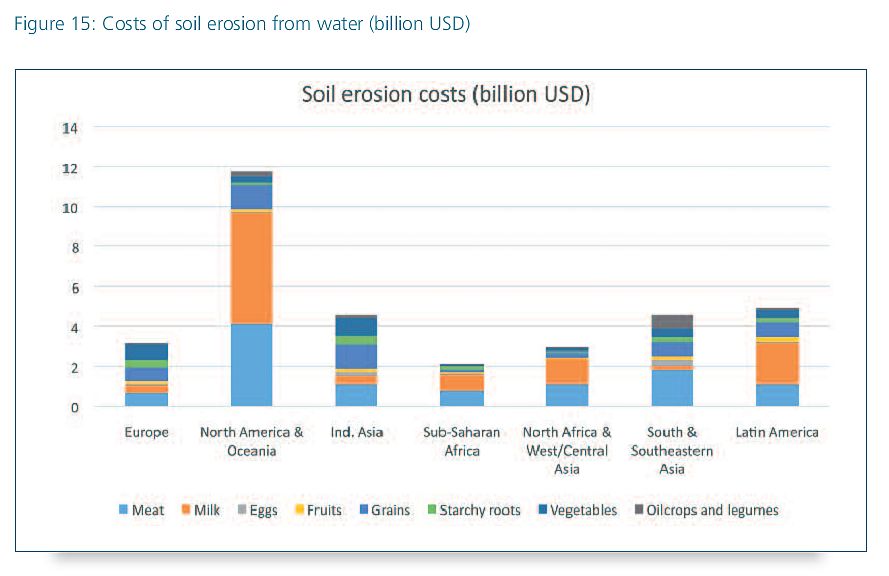
Introduction
The state of the art of soil erosion
research in Europe has recently been described in great detail in the
book Soil Erosion in Europe . The present
website is meant as an inventory and overview of the current state of
soil erosion control in Europe. The intention is also to make
existing information on soil erosion control practices readily
available to farmers, farmer's organisations, policy makers and other
interested parties in Europe. The site is a collection of links to
erosion control efforts in individual European countries that can be
found on the Internet. The site is far from complete. Many countries
are still lacking. Additions to the links below are therefore very
welcome. So, if you know of any initiatives or regulations to combat
soil erosion in Europe, please let me know. The site only deals with
soil erosion by rain, not by wind. It does not deal with other forms of
soil degradation than erosion.
Soil erosion control has not generally received sufficient attention in Europe, until recently. In most European countries, scientific interest in soil erosion arose in the 1970's. This was due to: (a) changes in agriculture (larger fields, more row crops, heavier machines), leading to an aggravation of erosion, and (b) a growing interest among earth scientists in the rate of operation, controlling factors and mechanisms of the so-called landscape forming processes, such as slope wash or hill wash. In some countries, concern for soil erosion is (much) older, like in Iceland, Poland, Bulgaria, Moldavia and Portugal. Today, there is sufficient knowledge in Europe to apply erosion control techniques and to experiment with the efficacy of those available. Not enough is done, however. Much of the failure to address the on- and off-farm impacts of soil erosion is a result nót of technical inadequacy, but of a failure to recognise the importance of socio-economic factors in influencing erosion (Soil Erosion in Europe, p. 485).
Erosion (by rain) is a natural process on sloping land. It is the detachment and downslope displacement of soil particles by raindrop impact (splash) and running water (overland flow). Under natural vegetation (e.g.forest) the rate of erosion is very low. The vegetation protects the soil. This is called 'normal erosion' or the 'geologic norm of erosion'. When the natural vegetation is removed, as in arable farming, the soil is exposed to rainfall and the rate of erosion may increase 100-1000 fold, compared to forest. This is called 'accelerated erosion' or 'soil erosion'. Thus, soil erosion is an (unintended and unwanted) consequence or side effect of agriculture. Most farmers nowadays are aware of this and are willing to take measures to counteract erosion, in their own interest and that of others. There are costs involved, however, and it may be necessary to induce farmers to take action. Incentives may be in the form of regulations or legislation, together with financial compensation (subsidies, tax reduction). The most recent study (on a European level), how to encourage farmers to adopt soil conservation practices is the SoCo-project. It was launched by the European Commission for the period 2007-2009.
Legislation is not primarily enforced upon farmers because of the irreversible loss of fertile topsoil and damage to the land, but because of the so-called off-site effects that accompany the loss of soil from cultivated land. The soil that is washed away, is deposited as mud on roads, in roadside ditches, in culverts and sewers, in the gardens, basements and cellars of houses, in the streets of built-up and residential areas and in rivers, dams and reservoirs. So, there may be serious damage to public and private property outside agriculture. Soil erosion is often also accompanied by flooding, and water quality may be impaired by erosion-derived agrochemicals. Legislation only exists in a few European countries today.
Many measures to prevent or reduce soil
erosion are known since the 1930's, mostly developed in the USA. These
measures need to be adapted to local conditions of climate, soil, slope
and field length and the type of crop that is grown on the eroded
fields. In general, we have a fair understanding of the mechanisms and
controlling factors of soil erosion and of the basic principles of soil
conservation. However, applying this knowledge to a given local context
seems to be difficult. Empirical tests (on plot and field scale) with
local crops and local farming systems are necessary to establish
conservation techniques that are effective and feasible. It is here,
that farmers and scientists must work together and bring in their skill
and expertise. Farmers can contribute their practical experience in
land management, and scientists their fundamental knowledge of erosion
processes and soil properties. This co-operation is best achieved on
experimental farms, where the different interests of farmers and
scientists may fruitfully come together. Ingram discusses in detail the
different outlooks of farmers and scientists in England, Switzerland
and France on soil erosion and conservation. This is a very important
issue that may complicate the application and implementation of erosion
control measures considerably. Click here to
read the paper. Most promising for the future seems to be so-called
conservation tillage, in its various forms (minimum tillage, zero
tillage, no till, direct drill, reduced tillage, strip till, mulch
till, non-inverting tillage).

Ephemeral gully crossing a number of
arable fields in the hilly loess district of Dutch South Limbourg after
55 mm of rain in 2 hours incl. 30 mm in 30 minutes (Photo D. Koeman).

Ground
view
of
same
ephemeral
gully
as
above.
The
plough
layer
was
washed
away
on
recently
drilled
fields
(Photo
F.
Kwaad).

Gully
erosion
in
loess
soil
in
Dutch
South
Limbourg
(Photo
F.
Kwaad).
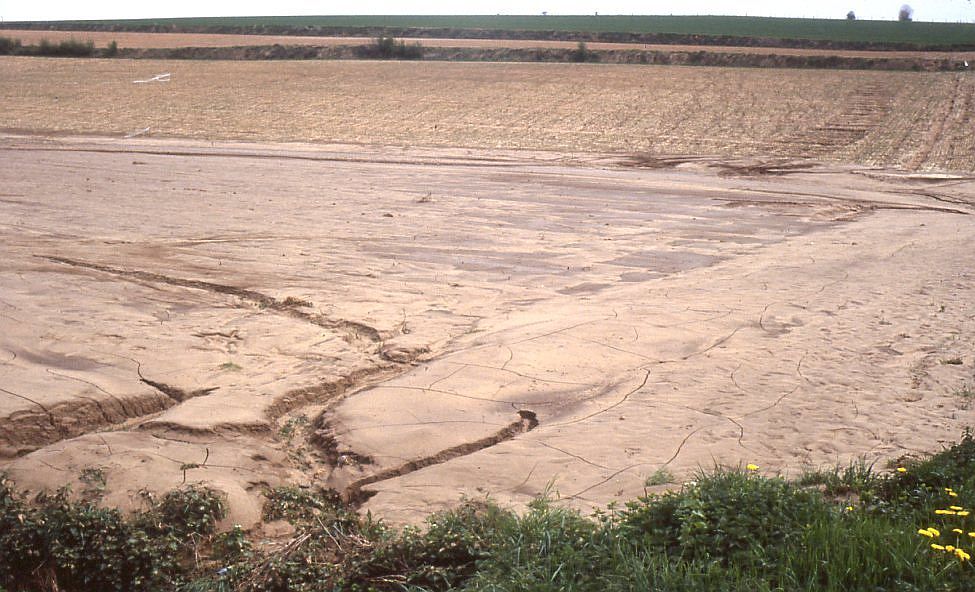
Deposition
of
eroded
soil
in
the
corner
of
a
sloping
field
in
Dutch
South
Limbourg
(Photo
F.
Kwaad).

Mud
on
the
street
and
pumping
of
cellar
in
Valkenburg,
Dutch
South
Limbourg,
after
an
erosion
event
(Photo
F.
Kwaad).
Links to websites
on practical aspects of soil conservation in Europe
Keep in mind, that more may be going on to
combat erosion in Europe than is reflected on the Internet. The
site is regularly searched for broken links with W3C Link Checker.
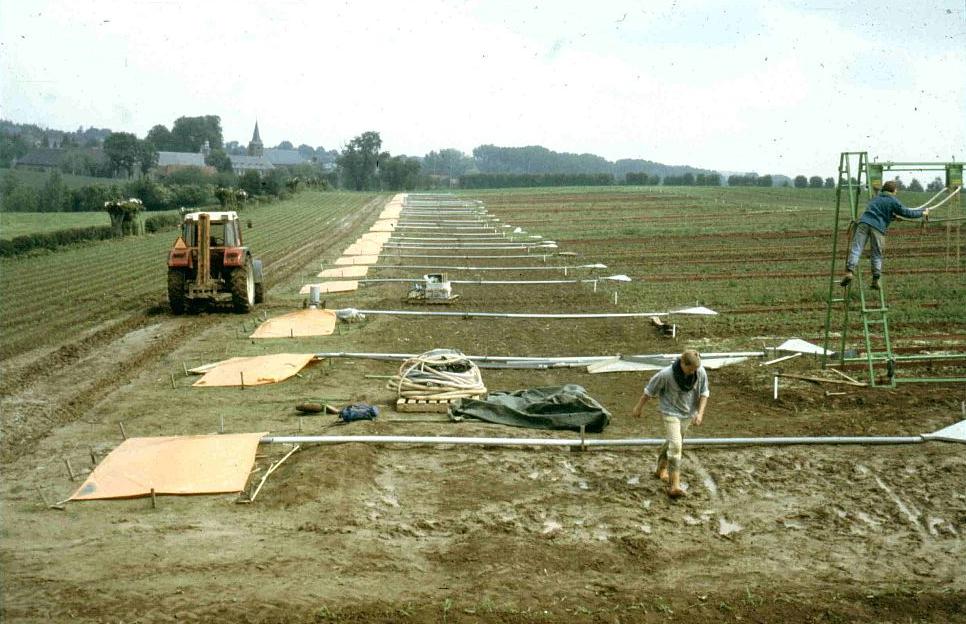
Soil conservation research using a
rainfall simulator on experimental plots in Wijnandsrade, South
Limbourg, The Netherlands (Plots laid out and photo F. Kwaad).
Multislot divisor for sampling runoff from
an experimental plot (Photo F. Kwaad).
Belgium
Bodemerosie
in België
Code van goede praktijk
erosiebestrijding
Wegwijzer doorheen
het erosiebesluit
Interreg-project
erosiebestrijding
Interreg
bedrijfserosieplan
Erosiebestrijding
MESAM
project
SOWAP
Images
of
conservation
work
Publicaties
erosiebestrijding
Voorbeelden
projecten
erosiebestrijding
Infokrant
"Werk
maken
van
erosiebestrijding"
Brochures
"Werk maken van erosiebestrijding"
Werk maken van
erosiebestrijding
Erosiebeperking
Oost-Vlaanderen
Erosiebestrijding
door
niet-kerende
grondbewerking
Bulgaria
Soil
erosion
control
in
Bulgaria
Croatia
Soil
erosion
under
different
tillage
methods
Denmark
Tillage
systems
Deutschland -
Germany
Bodenschutz
Bodenschutz in
Deutschland
Bundes-Bodenschutzgesetz
Bodenerosion
Mecklenburg-Vorpommern
Bodenerosion
Baden-Württemberg
Bodenerosion
Bayern
Gesellschaft für
konservierende Bodenbearbeitung
Kassa
-
Conservation
agriculture
in
Germany
Direktsaat
Direktsaat
Programm
Niedersachsen
Eastern Europe
Additions are welcome.
England - UK
RASE
-
The
Current
Status
Of
Soil
And
Water
Management
In
England
2009
Soil
erosion
in
the
UK
Soil
erosion
in
England
and
Wales
Soil
action
plan
for
England
DEFRA
DEFRA
-
Best
pratice
information
sheets
Sustainable
practices
to
limit
soil
erosion
Direct drilling (discussion
on British Farming Forum)
No-till wheat not for Western
Europe (discussion among British farmers)
France
L'érosion
des
sols
en
France
INRA
-
L'érosion
des
sols
Picardie
-
lutte
contre
l'érosion
Practical
soil
protection
in
vineyards
Hungary
Direktsaat
Körnermais
-
Direct
drilling
of
maize
Iceland
Soil
erosion
Soil
conservation
Soil erosion in Iceland
Rofabards
in
Iceland
Restoration
of
degraded
and
desertified
lands
Soil
conservation
service
Iceland
Soil
conservation
in
Iceland
RENO
-
Restoration
of
damaged
Ecosystems
in
the
Nordic
countries
Agricultural
Research
Institute
(RALA)
Italy
Soil
erosion
risk
in
Italy,
2003
SoCo:
Agricoltura
Sostenibile
e
Conservazione
del Suolo, 2007
SoCo:
case
study
Marche
region,
2007
Mediterranean
region
Erosion in
Mediterranean landscapes: Changes and future challenges (In:
Geomorphology, 2013)
Recondes - Mitigation
of desertification processes in Mediterranean Europe
Recondes
-
Practical
guidelines
for
minimal
intervention
Additions for Spain, Portugal,
Italy and Greece are welcome. See below for Spain.
Moldova
Moldova
soil
conservation
project
Scandinavian
countries
Additions are welcome.
Schweiz -
Switzerland
Swiss
no-till (Direktsaat)
Direktsaat und ihr Beitrag
zum Bodenschutz
Bodenschutz
Nordwestschweiz
Bodenerosion
Solothurn
Bodenschutz
Kanton
Basel
Southeastern Europe
Additions are welcome.
Spain - Espagne
AEAC.SV
-
Asociación
Española
Agricultura
de
Conservación
/
Suelos
Vivos
Ministerio
-
Medidas
para
la
conservacion
y
proteccion
del
suelo
Sustainable
olive
growth
in
Andalucia
(Olivar
sostenible)

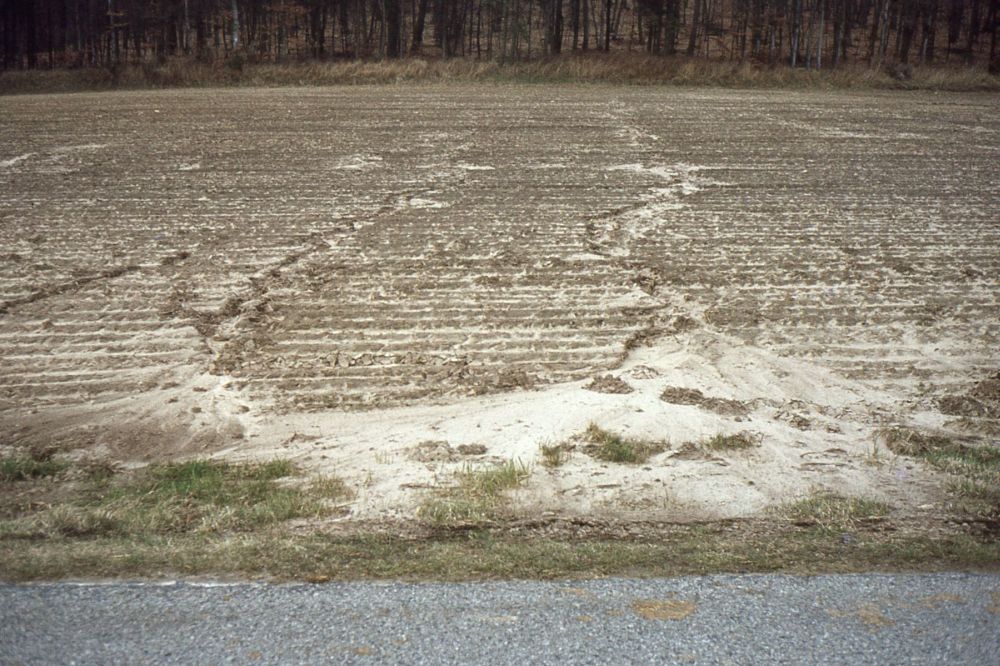
Rill erosion on a field that is tilled
along the contours (Luxembourg, Photo F. Kwaad)
In recent years, conservation tillage, in
its various forms, has become increasingly popular as a means to combat
soil erosion. In 2005, 40.7% of all cropland in the USA was under some
form of conservation tillage (US
Tillage
Trends). A global overview is given by Derpsch.
According
to
ECAF
agricultural conservation in Europe was very little developed in 1998
(estimated at <1%-2% of its agricultural land). France and
Spain are the two countries in Europe where these techniques are
practised the most, with about 1 and 0.6 million hectares of annual
crops under conservation techniques in 1998. This is increasing. The
following data for 2003 is given by ECAF for the percentage of the
agrarian surface under conservation agriculture:
Belgium
10%
Ireland
4
Slovaqia
10
Switzerland
40
France
17
Germany
20
Portugal
1.3
Denmark
8
United Kingdom 30
Spain
14
Hungary
10
Italy
6
A special form of conservation tillage is
subsurface tillage, i.e. non-inverting tillage with a type of plough
that cuts a slice of soil loose from the subsoil without inverting it.
As of 3 April 2008, farmers in Dutch South Limbourg can apply for a subsidy of 50 Euro per ha per year for
adopting non-inverting soil tillage. Starting 2013, conventional
ploughing will no longer be allowed in the region south of Sittard.
Click here to see the
regulation. Click here
for a recent paper in the European Journal of Agronomy (Vol. 33, 3,
October 2010) on the effect of conservation agriculture on crop yields
in Europe.

Non
inverting
plough
(From:
Geelen
)
The effectiveness of conservation tillage
for erosion control is due to:
(a) Providing the soil surface with a
protective cover of growing crop and/or crop remains at all times; this
prevents crust formation by raindrop impact (so called surface sealing)
that would lower the rate of infiltration of rain water below the rate
at which the rain falls.
(b) Conservation tillage helps forming and
maintaining a water stable soil structure. By conventional tillage a
mechanical, so called fragmentation structure is formed, the elements
of which (clods) are not stable in water. Under permanent vegetation a
surface horizon is formed with biogenic aggregates (peds) that are
stable in water. A stable soil structure is an important defence line
against soil crusting.

Crust formation on bare soil. Aggregate
breakdown hinders infiltration of rainwater and causes surface runoff
(overland flow) on sloping fields (From: Chapter 6 in Sare). See Imeson and Kwaad, 1990
and Kwaad-Mucher,
1994
for more information on the causes and mechanisms of the breakdown of
soil structure.
Infiltration excess overland flow occurs
when high intensity rain falls on a crusted or sealed soil. It can
begin immediately at the onset of rainfall, even on a dry soil. This
form of overland flow is called Horton or Hortonian overland flow.
Controlling variables are rainfall intensity and infiltration capacity
of the soil, both expressed in mm/h.
Another possible cause of overland flow is
the presence of an impeding layer at shallow depth in the soil. During
prolonged rainfall a perched groundwater table can form above the
impeding layer that may reach the soil surface. Lateral subsurface flow
over the impeding layer (throughflow, interflow) is involved in this,
resurfacing at some point downslope (return flow).
When and where the groundwater table is
already at the soil surface at the start of rainfall (such as can occur
along rivers and in lower parts of the landscape), overland flow can
begin immediately, irrespective of rainfall intensity.
The latter two forms of overland flow are
called saturated or saturation overland flow. Controlling variables are
rainfall amount and available storage capacity of the soil for water,
both expressed in mm.
NEW
Soil erodibility or K-factor map
of Europe
An important controlling factor of soil erosion is the soil erodibility
factor or
K-factor in the Universal Soil Loss Equation (USLE). The value of this
factor for Europe can be found on a K-factor
map that was recently published in "Environmental Modelling and Software"
(November 2011). This
map provides a complete picture of the soil erodibility in the European
Union member states. It is derived from the LUCAS 2009 point survey
exercise.
The soil erodibility dataset overcomes the problems of limited data
availability for K-factor assessment and presents a high quality
resource for modellers who aim at soil erosion estimation on
local/regional, national or European scale. The dataset is in raster
format and can be accessed on request.

A
model
of
hydrologic
processes
on
a
hillslope
(Source:
University
of
Colorado,
Boulder )

Direct drilling in no-tilled soil (From: John Dale Drills )

Direct drilling of maize in winterrye as
winter cover crop, Experimental Farm Wijnandsrade, The Netherlands (see
detail of sowing machine) (Photos F. Kwaad).

No till corn after corn (From: Wendy
Kindig ). Click here for detail.

Strip tilled corn (From: Mitchell et al. )